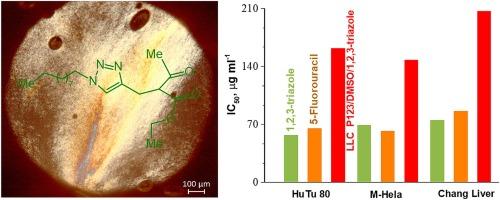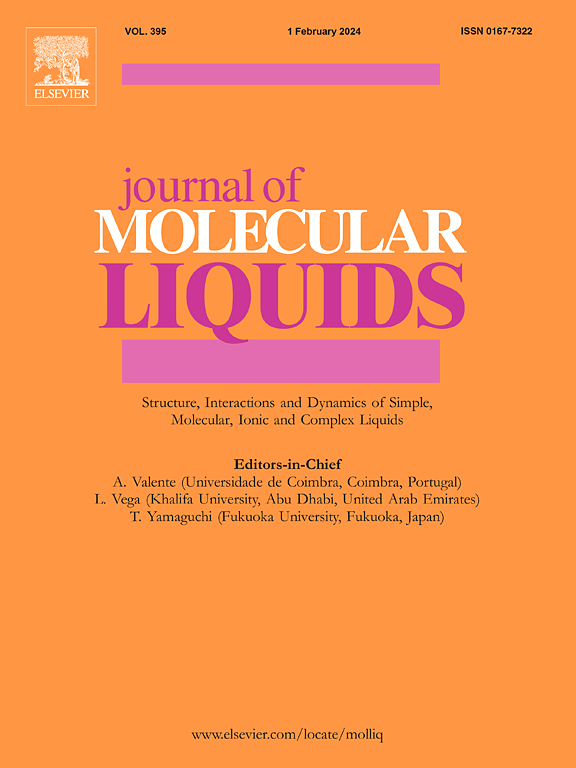掺杂 1,2,3-三唑衍生物的各向同性液晶系统的相行为和生物活性
IF 5.3
2区 化学
Q2 CHEMISTRY, PHYSICAL
引用次数: 0
摘要
杂环化合物是合成药物的重要原料,尤其是具有高生物活性的取代三唑类化合物。开发生物活性杂环化合物的给药系统对于改善生物制药方面的治疗尤为重要。在这项工作中,我们报告了一种新的 1,2,3-三唑:2-((1-癸基-1H-1,2,3-三唑-4-基)甲基)-3-氧代丁酸乙酯 (TR) 的合成和表征。实验证明,这种药物能有效地掺入溶解性介质中作为一种给药平台。偏振光学显微镜研究证实,在 P123/TR 二元体系以及添加了水、乙醇和二甲基亚砜的三元体系中形成了冻融介相。这样就可以将 5% 的三唑掺入溶菌酶中。红外光谱和紫外光谱研究检测到了 P123/TR 体系中发生的分子间相互作用。研究了二元和三元冻干酶中 TR 的释放情况。分析了成分和温度对释放时间的影响。对 M-Hela 和 HuTu-80 癌细胞株以及 Chang Liver 活细胞的细胞毒性评估显示,所研究的取代 1,2,3 三唑具有抗肿瘤特性。TR 对 HuTu-80 的最低 IC50 值为 57 μg-mL-1。这相当于参考药物氟康唑的水平。在浓度为 31.3-124 µg-ml-1 的 P123/DMSO/TR LLC 系统中,肝细胞的存活率与癌细胞的存活率相当。这些结果表明,P123/DMSO/TR LLC 有可能被用作 TR 递送剂,并增强其抗肿瘤效果。本文章由计算机程序翻译,如有差异,请以英文原文为准。

Phase behavior and biological activity of lyotropic liquid crystal systems doped with 1,2,3-triazole derivative
Heterocyclic compounds are important for the synthesis of pharmaceuticals, especially substituted triazoles, which have high biological activity. The development of approaches to the creation of delivery systems for bioactive heterocyclic compounds is of particular importance for improving the biopharmaceutical aspects of therapy. In this work, we report synthesis and characterization of a new 1,2,3-triazole: ethyl 2-((1-decyl-1H-1,2,3-triazol-4-yl)methyl)-3-oxobutanoate (TR). The efficient incorporation into lyotropic mesophases as a drug delivery platform demonstrated. Polarized optical microscopy studies confirmed formation of a lyotropic mesophase in the binary P123/TR system as well as in tertiary systems with added water, ethanol, and DMSO. This allows to dope 5 % of triazole into lyomesophases. IR and UV spectroscopy studies detected intermolecular interactions occurring in the P123/TR system. Release of TR from binary and tertiary lyomesophases was studied. Impacts of composition and temperature on the release time were analyzed. Evaluation of cytotoxicity to M-Hela and HuTu-80 cancer lines and Chang Liver living cells revealed antitumor properties of the studied substituted 1,2,3-triazole. The lowest IC50 of TR is 57 μg·mL−1 toward HuTu-80. This is at the level of the reference drug Fluconazol. For the P123/DMSO/TR LLC system in concentration range of 31.3–124 µg·ml−1, the viability percentage of liver cells is comparable to those of cancer cells. These results demonstrate the potential opportunity for application LLC P123/DMSO used as a TR delivery for and enhance its antitumor effect.
求助全文
通过发布文献求助,成功后即可免费获取论文全文。
去求助
来源期刊

Journal of Molecular Liquids
化学-物理:原子、分子和化学物理
CiteScore
10.30
自引率
16.70%
发文量
2597
审稿时长
78 days
期刊介绍:
The journal includes papers in the following areas:
– Simple organic liquids and mixtures
– Ionic liquids
– Surfactant solutions (including micelles and vesicles) and liquid interfaces
– Colloidal solutions and nanoparticles
– Thermotropic and lyotropic liquid crystals
– Ferrofluids
– Water, aqueous solutions and other hydrogen-bonded liquids
– Lubricants, polymer solutions and melts
– Molten metals and salts
– Phase transitions and critical phenomena in liquids and confined fluids
– Self assembly in complex liquids.– Biomolecules in solution
The emphasis is on the molecular (or microscopic) understanding of particular liquids or liquid systems, especially concerning structure, dynamics and intermolecular forces. The experimental techniques used may include:
– Conventional spectroscopy (mid-IR and far-IR, Raman, NMR, etc.)
– Non-linear optics and time resolved spectroscopy (psec, fsec, asec, ISRS, etc.)
– Light scattering (Rayleigh, Brillouin, PCS, etc.)
– Dielectric relaxation
– X-ray and neutron scattering and diffraction.
Experimental studies, computer simulations (MD or MC) and analytical theory will be considered for publication; papers just reporting experimental results that do not contribute to the understanding of the fundamentals of molecular and ionic liquids will not be accepted. Only papers of a non-routine nature and advancing the field will be considered for publication.
 求助内容:
求助内容: 应助结果提醒方式:
应助结果提醒方式:


